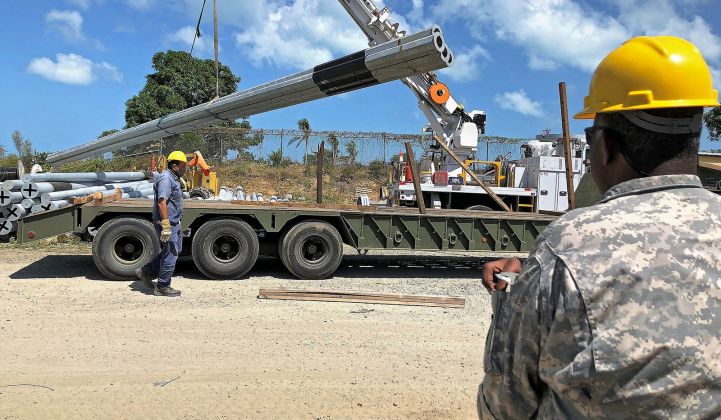Experts speaking at a congressional hearing this week indicated that plans for a more resilient grid have not yet coalesced in Puerto Rico.
Federal officials said work continues to move forward, but about 50,000 customers (i.e., meters) remain without power. The U.S. Army Corps of Engineers, which has spearheaded much of the repair work, is slated to draw down its presence on May 18. The Atlantic hurricane season begins on June 1.
Lawmakers questioned representatives from the Federal Emergency Management Agency, the Department of Energy and the U.S. Army Corps of Engineers (USACE) about when power would be 100 percent restored, how much a more resilient grid will cost, and how to ensure Puerto Rico doesn’t face a similar situation in years to come.
Concrete answers were few and far between.
“We’re going to do our best,” said Charles Alexander, director of contingency operations and homeland security headquarters at the USACE, when asked if his agency could reach 100 percent restoration before the agency is departs the island. After that date, Alexander said USACE will shift into supporting role for the island’s utility, the Puerto Rico Electric Power Authority.
Jeffrey Byard, associate administrator in FEMA’s office of response and recovery told lawmakers that as the island moves into the “last mile” of restoration, “it’s better for [PREPA] to start leading their recovery efforts.”
Carlos Torres, Edison Electric Institute’s Power Restoration Coordinator, said he believes PREPA can rise to the occasion, but he thinks “they are going to be challenged” by assuming control.
Puerto Rico's grid rebuilding hasn't included many of the resilience upgrades recommended by energy experts.
“While not the long-term resilient grid that we know we all need, the grid we’re restoring today is going to be in much better condition than the grid that was there last August,” said Alexander. “The work we have done is not all for naught. It’ll be a much improved grid [compared to] what was done previously.”
It remains unclear how much a re-engineered, resilient grid will cost — or when it will be completed. A report published in December by a group of electricity experts estimated it would take $17.6 billion and up to a decade to finish improvements. The Department of Energy said it’s not ready to offer up recommendations, but in 60 days it plans to have a model to help assess Puerto Rico’s needs.
“You just don’t build a grid overnight,” said Bruce J. Walker, assistant secretary of DOE’s office of electricity delivery and energy reliability. He said the department is working with its national labs as well as PREPA’s Transformation Advisory Council to vet and organize recommendations. Until that process reaches completion, he declined to offer a cost estimate.
Other uncertainties, including the impending privatization of PREPA and tensions over authority in regulating the island’s energy system, may slow decision-making.
For U.S. citizens in Puerto Rico, the hearing may bring little comfort.
“All of us want the power to be 100 percent restored and stronger than ever by hurricane season,” said Byard. “That’s not going to happen.”
Byard said the agency has prioritized both restoring and hardening critical facilities like hospitals, fire stations and police stations. But as of Wednesday, 881 generators remained in operation at critical facilities in Puerto Rico.
An analysis published Thursday by the Rhodium Group ranked Hurricane Maria as the world's second-largest storm-related blackout in history.




